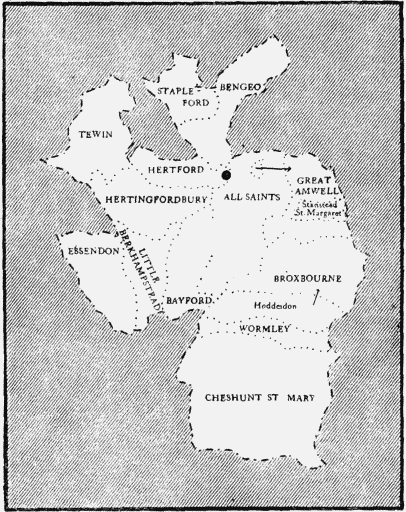A History of the County of Hertford: Volume 3. Originally published by Victoria County History, London, 1912.
This free content was digitised by double rekeying. All rights reserved.
'The hundred of Hertford: Introduction and map', in A History of the County of Hertford: Volume 3, ed. William Page( London, 1912), British History Online https://prod.british-history.ac.uk/vch/herts/vol3/pp407-408 [accessed 26 November 2024].
'The hundred of Hertford: Introduction and map', in A History of the County of Hertford: Volume 3. Edited by William Page( London, 1912), British History Online, accessed November 26, 2024, https://prod.british-history.ac.uk/vch/herts/vol3/pp407-408.
"The hundred of Hertford: Introduction and map". A History of the County of Hertford: Volume 3. Ed. William Page(London, 1912), , British History Online. Web. 26 November 2024. https://prod.british-history.ac.uk/vch/herts/vol3/pp407-408.
THE HUNDRED OF HERTFORD
CONTAINING (fn. 1) THE PARISHES OF
Hertford Hundred lies in the valley of the Lea, for the most part to the south of the borough of Hertford, which it almost encircles. Little is known of the spot where the courts were held, but it was apparently customary for the sheriff's tourn to be held at Ware Bridge in the 14th century. (fn. 2) The hundred adjoins the counties of Essex and Middlesex on the east and south respectively.

Index Map to the Hundred of Hertford
The hundred in 1086 was somewhat more extensive than at the beginning of last century. It originally included Bramfield on the north-west. (fn. 3) Four men and the reeve together with the whole township (villata) of Bramfield were wont to plead and to be geldable with the rest of the king's 'foreign' (forinsec) hundred of Hertford; but about 1260 Abbot John of St. Albans annexed Bramfield to his liberty, (fn. 4) and thenceforward it was accounted part of the abbots' hundred of Cashio. (fn. 5) The Domesday Survey also locates the unidentified holdings of Stiuicesworde and Bricewold within the hundred of Hertford. (fn. 6) The royal jurisdiction here as elsewhere was considerably diminished by the liberties exercised by religious houses over their lands. The Abbot of Westminster claimed exemption from suit at the hundred court for his tenants at Amwell, the Knights Templars for theirs in Bengeo. The tenants of Waltham Holy Cross had a similar exemption in the liberty of Brickendon and at Wormley. The men of the hospital of St. Bartholomew at Tewin, and those of Hertford Priory, Merton Priory and the Priory of Holy Trinity Aldgate, had all withdrawn their suit from the hundred by 1278. (fn. 7)
The hundreds of Hertford and Braughing were usually farmed jointly by a single bailiff. (fn. 8) The value of Hertford Hundred in 1278 was £10 yearly. (fn. 9) Early in the year 1319 inquisition was made as to the possibility of severing these two hundreds from the body of the county; but their value was uncertain, since the sheriff accounted for the whole county in gross. (fn. 10) In 1335 the petition of Edmund 'de Bolestroda,' a servant (valet) of Henry of Lancaster, who desired to hold the two hundreds severally at farm, was rejected, as it was proved to the Council that they were of the body of the county and could not be separated. (fn. 11) No such consideration weighed with Queen Elizabeth, who in 1571 granted these and other hundreds to William Cecil Lord Burghley and his heirs, to hold in fee farm. (fn. 12) Burghley's son, Robert Earl of Salisbury, bequeathed them to his son and heir William, (fn. 13) and they have descended with the earldom of Salisbury.
